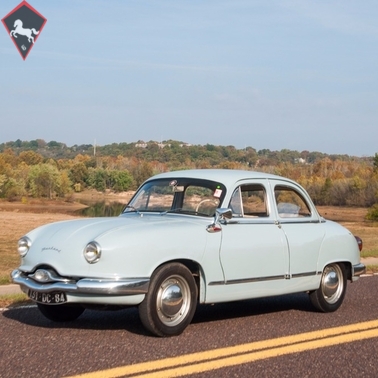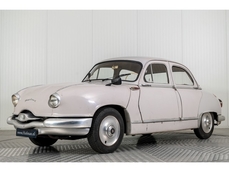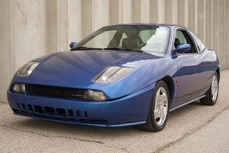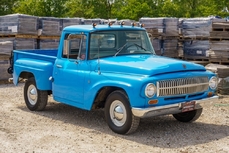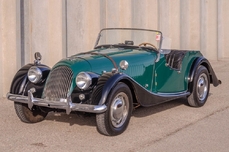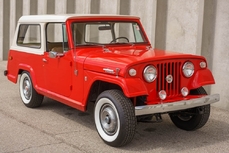Panhard Dyna Z .9L flat two-cylinder 1957
General description :
1957 Panhard Dyna Z
Aluminum body construction (last year for the aluminum)
850cc flat air-cooled, two-cylinder engine 42HP
Four-speed column-mounted manual transmission
Light blue exterior with blue and white interior
Front-wheel drive and four-wheel drum brakes
Center-mounted fog light
Previously part of the famous Blackhawk Collection
Rare US Market car distributed by French Motors in LA California
The French have always been known for doing things differently; for asking why not when others ask why and MotoeXotica Classic Cars has a rolling example of this thought process with a rarely seen 1957 Panhard Dyna Z.
The car’s paint and trim are in overall very good order. The windows are clear and crack-free while the lights, including the center-mounted fog light, are haze-free and in one piece. This car rides on Michelin 145R40 tires surrounding 16-inch steel wheels with full moon wheel covers.
The car’s aluminum bodywork is solid and straight, the trunk is in good order with a full-sized spare tire, the engine bay is tidy and the bumpers fit well to the car’s body overall.
Under the car’s clamshell hood is a .9L, flat, air-cooled, two-cylinder engine. It featured a concentric torsion bar valve springs on roller bearings, hollow aluminum push rods with hardened steel tips, roller main bearings and big end rod bearings of “Panhard Patent” design with an additional set of smaller rollers carrying the roller cage (separator); non-removable cylinder heads, removable steel cylinder liners. The cylinder “jugs” pulled off the crankcase and pistons like those of Volkswagen air-cooled engines. Soft engine mounts to smooth the engine’s roughness, a radial flow fan bolted to crankshaft, full cooling shroud, aluminum structure and cooling fins. Herringbone timing gears, steel pinion and a “Celcon” phenolic gear running with slight interference fit, permissible due to the flexibility of the Celcon.
The 850cc engine is connected to a cable-operated four-speed manual cast aluminum case transaxle with second and third synchromesh, transfer gears and second, third and fourth of “herringbone” design with a column shift. Unlike most front-wheel drive inline engine transaxles, the Panhard gearbox is between the engine and the final drive. The final drive spiral bevel gear is on a primary shaft, then a step-down to differential gear through helical (not herringbone) pinion and gear. The drive shafts concentric tubes with rubber in the space between the inner and outer tubes and cardan (“universal”) joint at the inner end next to the transaxle, double cardan constant velocity joint at the outer end at the wheel. The car stops via four-wheel drum brakes.
Inside, the original blue and white bench seats that can hold six average-sized people are in overall good shape but show some wear from age. The benefit of front-wheel drive is obvious in the car’s roomy interior, no center hump needed for a driveshaft as on a rear-drive vehicle. The carpet is fair while the headliner is in good overall condition but has some blemishes. The car’s futuristic instrument panel is in good order, as is the two-spoke steering wheel. The car’s shift lever is column-mounted, eliminating the need for a floor-mounted shifter and free space for a front center passenger. The inner door panels, mirror glass and shift lever are in good shape. There is a blemish on the passenger side between the doors.
In 1955, Citroën had taken a 25 percent holding in Panhard’s automobile business and during the next two years the national dealership networks of the two businesses were integrated. This gave Citroen and Panhard dealers expanded market coverage, incorporating now a small car, a medium-sized saloon and a large car range. It gave the Panhard Dyna Z, during its final years in production, a level of market access that its predecessor had never enjoyed and sales benefitted.
The more streamlined Dyna Z replaced the Dyna X in 1954. Like its predecessors, the Dyna X and the Panhard Dynavia concept that influenced its design, the Dyna Z’s body was originally aluminum with steel tube sub-frames front and rear joined by steel plate reinforcements in the sills. The decision to use aluminum sheeting for car bodies had been taken at a time when a sudden drop-off in demand for fighter planes had left the producers with a glut of the metal but in subsequent years the relative cost advantage of sheet steel had increased steadily. In summer 1954, the cost penalty of persisting with aluminum bodywork had become financially insupportable and in fall 1955 the latest Dyna Type “Z1” had steel bodywork (doors, trunk and hood were still in aluminum though).
This car is currently located at our facility in St. Louis, Missouri. Current mileage on the odometer shows 38,746 kilometers or 24,076 miles. It is sold as is, where is, on a clean and clear, mileage exempt title. GET OUT AND DRIVE!!!
Click here for our YouTube video!
OR Copy & Paste the Link Below to watch the video:
youtu.be/cLS7Z078-hc
VIN: 1038497
https://www.motoexotica.com/inventory/listing/1957-panhard-dyna-z/
1957 Panhard Dyna Z .9L flat two-cylinder is listed sold on ClassicDigest in Fenton (St. Louis) by for $17900.
Car Facts
Car type : Car Make : Panhard Model : Dyna Z Model Version : .9L flat two-cylinder Engine size : 0.0 Model Year : 1957 Sub type : Sedan Location : Fenton (St. Louis)
Sold
Seller Information
Sold
People who viewed this Panhard Dyna Z also viewed similar Panhard listed at ClassicDigest
Other cars listed for sale by this dealer
About Panhard
Panhard: A Brief HistoryEarly Years and Foundation:
Origins: Panhard et Levassor, founded in 1887, initially manufactured woodworking machinery before transitioning to automobiles.
Pioneering Automobiles: Among the first to produce cars with Daimler engines, Panhard swiftly gained recognition for its engineering prowess.
Notable Contributions and Innovations:
Front-Wheel-Drive Pioneers: Panhard introduced front-wheel-drive technology in the 1930s with models like the Dyna X and Dyna Z, revolutionizing automotive design.
Aluminum Construction: Known for employing aluminum bodies, Panhard's use of lightweight materials improved fuel efficiency and handling.
Models and Noteworthy Innovations:
Panhard Dyna X (1945-1954):
Innovation: The Dyna X showcased front-wheel-drive technology with a lightweight aluminum body shell, enhancing performance and fuel efficiency.
Engine: Inline-4 engine with various displacements.
Panhard Dyna Z (1954-1959):
Advancements: A continuation of Panhard's front-wheel-drive philosophy with improved design and engineering.
Engine: Inline-4 engine, offering enhanced performance.
Panhard 24 (1963-1967):
Styling: Introduced a sleek, aerodynamic design, and available in different body styles.
Engine: Utilized various Inline-4 engines for different trim levels.
Panhard 24 CT (1967-1968):
Refinements: A revised version of the Panhard 24 with minor design enhancements and improved performance.
Engine: Inline-4 engine options.
Panhard CD (1962-1965):
Racing Pedigree: Primarily designed for racing, featuring an aerodynamic body and lightweight construction.
Engine: Inline-4 engine tuned for performance.
Legacy and Impact:
Engineering Innovations: Panhard's pioneering use of front-wheel-drive and aluminum construction influenced automotive designs, contributing to advancements in efficiency and handling.
Niche Market: Despite innovative engineering, Panhard faced challenges in a competitive market, eventually leading to financial struggles and ceasing automobile production in the late 1960s.
Panhard's legacy lies in its groundbreaking engineering innovations, particularly with front-wheel-drive technology and lightweight aluminum construction, leaving an indelible mark on automotive design despite its limited lifespan as an automobile manufacturer.
